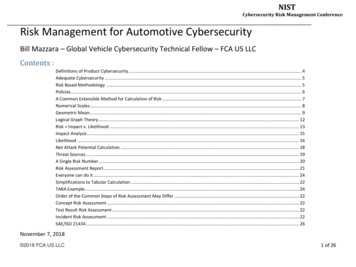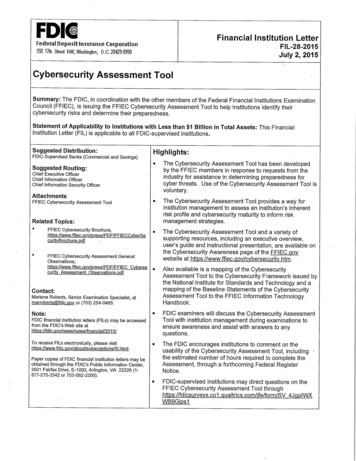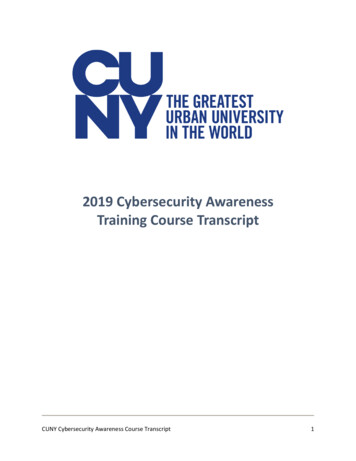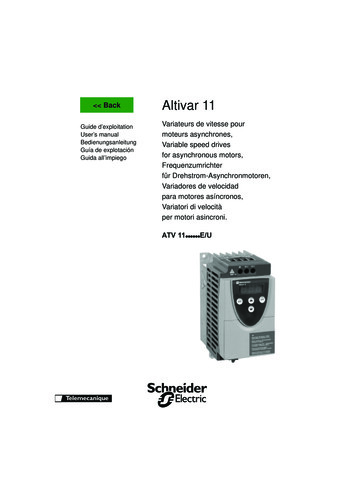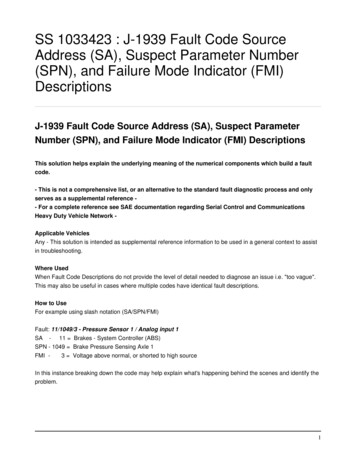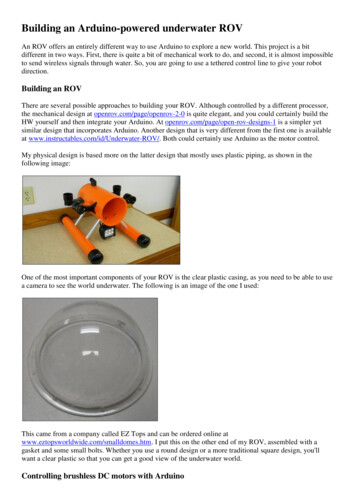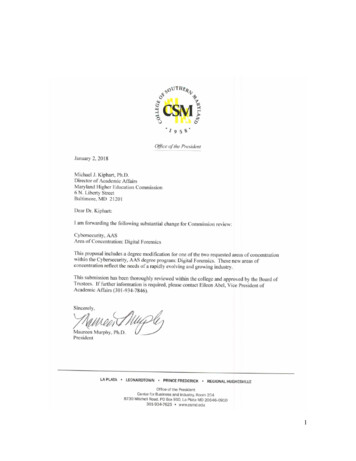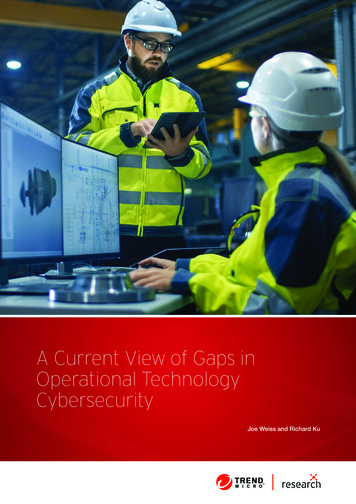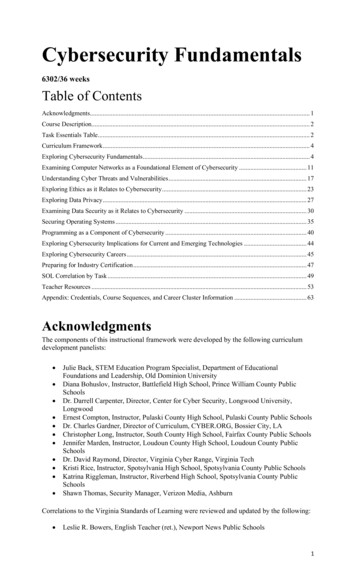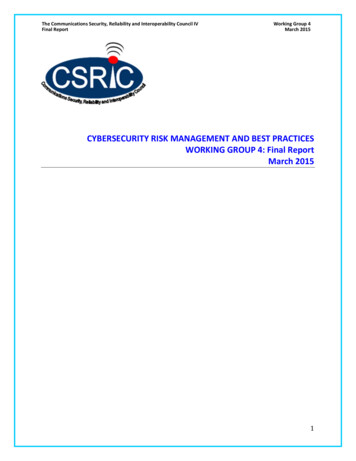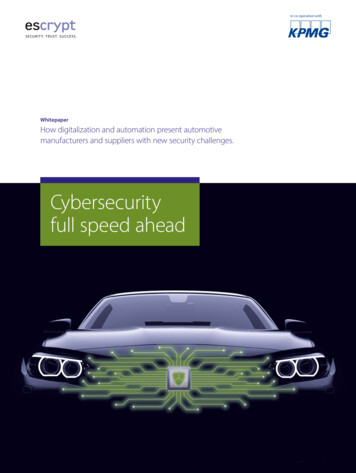
Transcription
in co-operation withWhitepaperHow digitalization and automation present automotivemanufacturers and suppliers with new security challenges.Cybersecurityfull speed ahead
When Carl Benz unveiled the automobile in 1886, he had rather different safety/securityconcerns than today’s automakers. From mechanical safety to the invention of the seatbelt, a century of automotive development would play out before cybersecurity becamerelevant. Since then, various cyber attacks on cars have brought the topic to the attention of the general public and of lawmakers. A working group at the United Nations isnow developing a regulation that represents a paradigm shift for the entire sector: in thefuture, the type approval of vehicles will be possible only when a certified cybersecuritymanagement system (CSMS) is in place. This means cybersecurity needs to be on theagenda of every automotive CEO.2Cybersecurity full speed ahead ESCRYPT GmbH. All rights reserved.
ContentsEvolution of automotive cybersecurity4New requirements for cybersecurity in vehicles5UNECE WP.29 TF-CS/OTA5ISO/SAE 214345Impact on the automotive industry6Expert support7Cooperation of ESCRYPT and KPMG7Proven approach7Building on existing strengths7 ESCRYPT GmbH. All rights reserved.Cybersecurity full speed ahead3
Evolution ofautomotive cybersecurityOne of the first published hacks of an automobile was carried outby a group of scientists led by Stephen Checkoway in 2009. Theydescribe how they connected a laptop to the car’s onboard diagnostics port in order to gain access to the vehicle’s internal network. This allowed them to manipulate critical systems in the car.For example, they were able to switch off the engine and blockthe brakes. In such attacks, scientists use various weak points inthe vehicle network and ECUs to send manipulated data recordsto the car’s embedded systems and tamper with their functions.Although hackers would be hard pushed to connect a laptop tothe vehicles of their victims, they could nonetheless use smaller,remote-controlled devices to wreak their mischief and jeopardizethe safety of road users.In 2010, a 20-year-old managed to manipulate over 100 cars viaremote control, such that they would no longer start. The “TexasAuto Center” rental company had fitted hardware in its hire carsthat could be controlled via an online system. This system allowedthe rental firm to deactivate the ignition if the customer did notpay. The hacker had been made redundant a short time previouslyand now gained access to the system via an employee account.Subsequently, he got control of the corresponding hardware components of the rental car fleet.4Cybersecurity full speed ahead ESCRYPT GmbH. All rights reserved.An even more critical situation arose in 2015, when Charlie Millerand Chris Valasek managed to take remote control of a Jeep. Via theSUV’s entertainment system, they gained access to its multimediasystems, windshield wipers, and air-conditioning system and controlled the brakes and the speed of the vehicle. They stopped thecar, whose driver had been hired as a tester, in the middle of thehighway. To do this, they did not need a cable to connect up withthe car as in the paper from 2009, but used the vehicle’s internetconnection. As a result, Chrysler had to recall and patch around 1.4 million vehicles.These days, there are regular reports of new attacks, most of whichexploit the increasing digitalization and connectivity of vehicles.This development highlights the risk that insufficiently protectedvehicles pose for manufacturers, owners, and road users. With theincreasing number and complexity of the IT systems fitted in cars,the demands placed on cybersecurity are growing rapdily. Viewing a vehicle as a closed-off system is the opposite of an adequate,risk-based security approach. New digital (online) services beingoffered in cars, communication between vehicles and manufacturers (over-the-air updates), vehicle-to-vehicle communication(car-2-car), communication between cars and infrastructure (car2-infrastructure), and communication with smartphones and devices from third-party providers – all these developments pre senthuge attack surfaces that need to be systematically analyzed andcontrolled.
New requirements forcybersecurity in vehiclesActivities are underway worldwide to further regulate and standardize automotive cybersecurity. There are legislative proposalsin the US Congress, the Cybersecurity Act in the EU, the ChineseICV program, and new guidelines from JASPAR in Japan. They allshare three main trends: a stronger focus on the specifics of theautomotive industry when addressing cybersecurity; the challengeand requirement to uphold security in the field; and the increasingly compulsory nature of regulations and the inclusion of cybersecurity at type approval. These trends are particularly visible in theUNECE WP.29 TF-CS/OTA and in the ISO/SAE 21434, which defineexplicit management systems for the protection of vehicles.UNECE WP.29 TF-CS/OTAThe United Nations World Forum for Harmonization of Vehicle Regulations (WP.29) adopted the regulation that makes cybersecurityrelevant for the approval of new vehicle types. The TF-CS/OTA taskforce’s proposal consists of two core requirements: the operationof a certified cybersecurity management system (CSMS); and theapplication of the CSMS to the specific vehicle type at the timeof type approval. The EU is planning to make these requirementsmandatory from 2022.the specifics of the automobile into account. In addition to the highcomplexity of both the product and the supply chain, other criticalaspects are the interactions with functional safety, the observanceof environmental regulations, and theft protection.ISO/SAE 21434Alongside the TF-CS/OTA, the automotive industry is also developing the ISO/SAE 21434 standard for the cybersecurity of vehicleswithin the framework of the International Organization for Standardization (ISO) and SAE International. Similar to the CSMS definedby WP.29, this standard puts the focus on appropriate security organization and having adequate processes throughout the life cycleof vehicles in order to protect them from cyber attacks. Given thatan accompanying document to the UN draft regulation refers consistently to this standard for the implementation of CSMS requirements, the ISO/SAE 21434 warrants particular attention. It will createan industry-wide common terminology and joint understanding ofkey activities upon which manufacturers and suppliers can buildtheir interfaces shared responsibilities, and processes. The final version is expected at the end of 2020. Considering typical development times in the automotive sector,manufacturers and suppliers need to start implementing thesecybersecurity requirements today to ensure their next productsreceive type approvals. To do this, they must follow a risk-basedapproach that can continuously determine, achieve, and maintaina suitable risk level for the vehicle type, its external interfaces, andits subsystems. This includes managing dependencies and information from suppliers, service providers, and other third parties from acybersecurity perspective.In view of the constantly changing threat environment and thelength of vehicle type lifetimes, a primary focus of a compliant CSMSis on the phase after the start of production and on continuousrisk management during vehicle operation. As a result, automotivesecurity must be tackled on the technical and the organizationallevel. While manufacturers and suppliers can draw on experiencewith information security standards such as the ISO 27000 series,the principal challenge in the design of a CSMS consists of taking ESCRYPT GmbH. All rights reserved.Cybersecurity full speed ahead5
Impact on theautomotive industryThe automotive industry is no stranger to government regulation.However, there have been only a few examples of statutory regulations relating to automotive product security. On account of OEMs’growing demand for transparency about their suppliers’ maturityof information security, the German Association of the AutomotiveIndustry (VDA) has drawn up a catalog for information security assessments (ISAs). With the Trusted Information Security AssessmentExchange (TISAX) model, OEMs have a mechanism at their disposalfor checking how suppliers handle sensitive data, based on thecatalog – for example, in the context of prototypes.In addition to TISAX, ISO/SAE 21434 now also sets requirements forcybersecurity and product security. In recent years, the automotiveindustry has strengthened vehicle protection. With the advent ofResources&CulturePro d u c ti o niontect &RespoProduction &OperationsConcept &lopmentDevem e nt ateidnsatn & ValDeImpleti owvieReficaio nVe t SecurityOrganizationFrameworkthe UN regulation, however, cybersecurity will be binding; rather,it will become a prerequisite for business success and competitiveness for both manufacturers and suppliers. In the context of thedigital transformation, it is a question not just of fulfilling the regulation, but of finding the best possible approach with the maximumeffectiveness for the corporate strategy and product roadmap.Companies must implement comprehensive organizational andtechnical measures that will enable them to define, control, manageand improve cybersecurity on an ongoing basis along the entirevalue chain. Consequently, demand is already growing today forwhat are known as gap analyses, which measure a CSMS’s implementation status and derive targeted improvement roadmapsbased on the results. RiskManagementimationdagnL ane pt & D eserUpCoeatncyThrSharingThreat IntelligenceRisk AssessmentRisk TreatmentVulnerability Managementte & R e covCybersecurity full speed aheado lderManag emento m m issi oEcosystem ESCRYPT GmbH. All rights reserved.i li tyecD6A n al y siskehnpeInfcaordsStaC apli tab iy&RespsibonSource: ESCRYPT
Expert supportLike many other industries, the automotive industry will face ashortage of skilled personnel in this field. Experts who understandboth cybersecurity and the special requirements of the automotiveindustry are rare. At the same time, digitalization is raising cyberrisk levels so fast that in-house knowledge for automotive productsecurity typically does not keep pace. Companies will find it difficultto solve all security challenges with their own resources in time.The inclusion of cybersecurity in type approval means it is criticalto reliably implement all requirements as efficiently as possible atthe first attempt.Cooperation of ESCRYPT and KPMGThe consultancies ESCRYPT and KPMG offer expert services to guidemanufacturers and suppliers successfully through the process ofdeveloping compliant security solutions. ESCRYPT has a wealthof experience in taking automotive cybersecurity from conceptto series production and subsequently maintaining the targetedsecurity level during operation. KPMG is an expert in informationsecurity and in the assessment and rollout of security managementsystems. Their cooperation takes these strengths and combinesthem to a holistic approach that increases the utility for customers.For example, any changes that are required at the organizationaland process levels can be designed in such a way that the effectson the development and the operation of the security solutions aretaken into account and optimized.Proven approachESCRYPT and KPMG support the automotive industry in all relevantmarkets and niches, from manufacturers of luxury sports cars tothe global top 5 OEMs and leading suppliers for highly automateddriving. The services follow a proven methodology based on decades of experience that the cooperation partners have built up.The framework for rolling out a CSMS consists of three main steps:a) preparation, b) implementation and c) commissioning and continuous improvement.Building on existing strengthsIn light of the complexity of the overall challenge posed by digitalization and the onus of proving cybersecurity that will soon becompulsory for type approval, it is vital to avoid reinventing thewheel. Instead, existing strengths must be leveraged and buildupon and partial solutions must be integrated into a full compliant cybersecurity management system. Existing strenghts mayinclude information security management systems (ISMSs), qualitymanagement systems and established practices for achieving functional safety. To help with this process, ESCRYPT and KPMG offerspecialized audits and fit/gap analyses that identify potential gapsto the relevant standards and uncover existing strengths, enablingcompanies to establish benchmarks and prioritize measures thatwill maximize return on investment and lead companies to theirgoal by the quickest and best possible route. Proven and structured methodology for rollout of a ybersecurity OrganizationMonitoring & EvaluationStocktakingRisks & OpportunitiesContinuous ImprovementCompatible Frameworkfor IntegratedManagement SystemsPeople & ToolsEcosystem OrchestrationLaunch of CSMSOperation and PlanDo-Check-Act cycleCSMSreadyTypeApprovalSource: ESCRYPT ESCRYPT GmbH. All rights reserved.Cybersecurity full speed ahead7
ContactDr. Moritz MinzlaffSenior Managermoritz.minzlaff@escrypt.comTelephone 49 30 40369-1901Hans-Peter FischerPartner, Cyber Securityhpfischer@kpmg.comTelephone 49 69 9587-2404Dr. Martin EmeleVice President Cybersecuritymartin.emele@etas.comTelephone 49 711 3423-3054Jan StöltingSenior Manager, Cyber Securityjstoelting@kpmg.comTelephone 49 69 9587-6273ESCRYPT GmbHWittener Straße 4544789 Bochum, GermanyTelephone 49 234 43870-200info@escrypt.comKPMG AG WirtschaftsprüfungsgesellschaftTHE SQUAIRE60549 Frankfurt, GermanyTelephone: 49 69 almediaThe information contained herein is of a general nature and is not intended to address the circumstances of any particular individual or entity. Although we endeavour toprovide accurate and timely information, there can be no guarantee that such information is accurate as of the date it is received or that it will continue to be accurate in thefuture. No one should act on such information without appropriate professional advice after a thorough examination of the particular situation. ESCRYPT GmbH. All rightsreserved.Status: 10/2020
and requirement to uphold security in the field; and the increas-ingly compulsory nature of regulations and the inclusion of cyber-security at type approval. These trends are particularly visible in the UNECE WP.29 TF-CS/OTA and in the ISO/SAE 21434, which define explicit management systems for the protection of vehicles. UNECE WP.29 TF-CS/OTA
